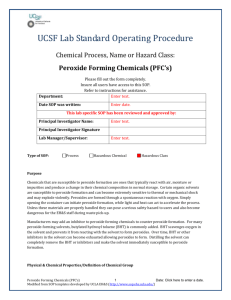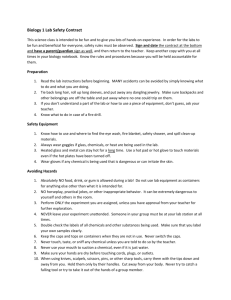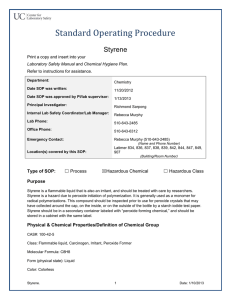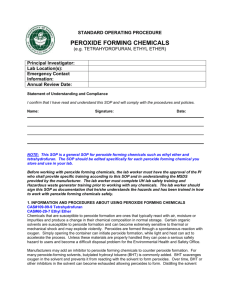Peroxide Forming Compounds - Texas Tech University Departments
advertisement
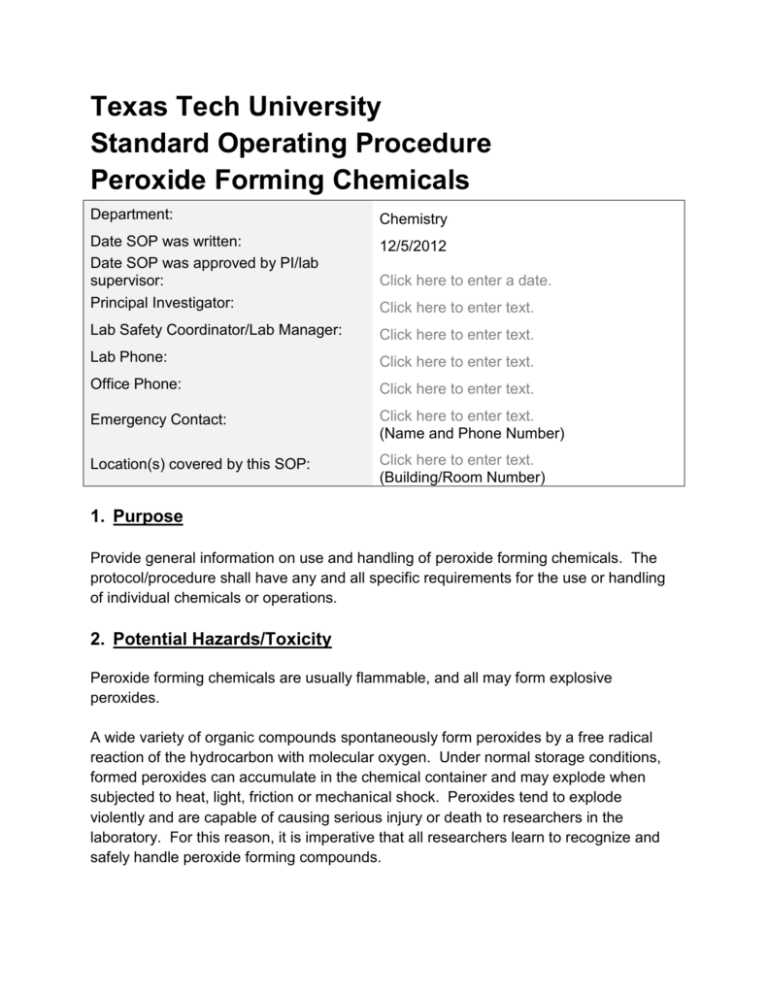
Texas Tech University Standard Operating Procedure Peroxide Forming Chemicals Department: Chemistry Date SOP was written: Date SOP was approved by PI/lab supervisor: Principal Investigator: 12/5/2012 Lab Safety Coordinator/Lab Manager: Click here to enter text. Lab Phone: Click here to enter text. Office Phone: Click here to enter text. Emergency Contact: Click here to enter text. (Name and Phone Number) Location(s) covered by this SOP: Click here to enter text. (Building/Room Number) Click here to enter a date. Click here to enter text. 1. Purpose Provide general information on use and handling of peroxide forming chemicals. The protocol/procedure shall have any and all specific requirements for the use or handling of individual chemicals or operations. 2. Potential Hazards/Toxicity Peroxide forming chemicals are usually flammable, and all may form explosive peroxides. A wide variety of organic compounds spontaneously form peroxides by a free radical reaction of the hydrocarbon with molecular oxygen. Under normal storage conditions, formed peroxides can accumulate in the chemical container and may explode when subjected to heat, light, friction or mechanical shock. Peroxides tend to explode violently and are capable of causing serious injury or death to researchers in the laboratory. For this reason, it is imperative that all researchers learn to recognize and safely handle peroxide forming compounds. Peroxide forming chemicals may also have other hazardous properties including toxicity. Safe use requires assessing all potential hazards. Refer to specific chemical SOPs and SDSs for specific toxicity and other hazards. 3. Engineering Controls Work with peroxide-forming chemicals must be conducted in a fume hood unless other controls are designated in the Protocol/Procedure section. Sash height must be kept low to avoid escaping fumes and to provide an explosion barrier. Use supplemental explosion protective equipment like a blast shield where appropriate to protect from explosions in the case of peroxide detonation. 4. Personal Protective Equipment (PPE) Lab-specific information on PPE selection must be included in the Protocol/Procedure. Hand Protection Handle with appropriate, impermeable gloves. Gloves must be inspected prior to use. Dispose of contaminated gloves after use or when they become contaminated in accordance with good laboratory practices. Gloves must be removed prior to exiting laboratory unless a chemical is being transported to another laboratory. Wash and dry hands each time gloves are removed. Avoid touching any non-work surface with gloved hands (door knobs, computers, phones, filing cabinets, desk areas, etc.). For reference of glove selection use: http://www.ansellpro.com/download/Ansell_8thEditionChemicalResistanceGuide.pdf or http://www.masterflex.com/requests/literature/Kimberly-Clark_Glove-Chem-Guide.pdf Specific information on glove selection must be included in the Protocol/Procedure. Eye Protection Tightly fitting safety goggles. Use face shield (8-inch minimum) when appropriate (when not protected by fume hood sash for example). Use equipment for eye protection tested and approved under appropriate government standards such as NIOSH (US) or EN 166(EU) or ANSI Z87-1. Skin and Body Protection Appropriate lab coat and no exposed skin from the waist down. Required shoes are closed-toed, non-fabric/non-absorbent shoes that are kept securely tied or fitted. Hygiene Measures Handle in accordance with good industrial hygiene and safety practice. Wash hands before breaks, at the end of the workday and when gloves are removed or may have come in contact with chemicals. Respiratory protection Do not buy any respiratory equipment without EH&S department’s permission. Contact EH&S regarding the respiratory program at 742-3876. 5. Exposures/Unintended Contact Contact the principal investigator (PI) of the laboratory or Environmental Health & Safety for advice on occupational chemical exposures. In the event of an actual chemical exposure have the PI and Environmental Health & Safety notified immediately, complete an incident report as soon as possible and submit to EH&S. If skin contacted: Immediately remove contaminated clothing and rinse with water for at least 15 minutes. Seek medical attention if needed after 15 minutes of rinsing or if a large area of the body comes in contact with a particularly hazardous substance. For eye contacted: Immediately rinse eyes with copious amounts of water for at least 15 minutes, while occasionally lifting upper and lower lids. Preferably, this is to be performed at an eye wash station. Medical attention may be required. If ingested: Seek medical attention immediately. Never give anything by mouth to an unconscious person. If large amounts of aerosols are inhaled: Move the person to fresh air and seek medical attention immediately. . 6. Working alone Certain extremely hazardous operations should not be performed if the PI or Lab Safety Contact(s) are not present. Never work alone with extremely hazardous materials/operations. See the protocol/procedure for specific prohibitions (if any) on working alone. 7. Work Practice Controls Read the Material Safety Data Sheet (MSDS) for any peroxide forming chemical before starting a procedure. Store peroxide forming chemicals only with compatible chemicals. If gloves come in contact with a hazardous substance through a splash (or otherwise), they should be removed, discarded properly and changed immediately. Purchase peroxide forming chemicals in the smallest containers that are practical for lab use. Place a peroxide forming label on each container and have date received, date opened and date of the last peroxide test. Test for peroxide formation every 6 months. NEVER distill potential peroxide-forming chemicals to dryness. Always leave a minimum of 20% still bottoms. When possible, add a non-volatile organic compound (such as mineral oil) to dilute any peroxides remaining after distillation Use extreme caution before concentrating or purifying peroxide forming chemicals as most explosions occur during these processes. Use appropriate full personal protective equipment (lab coat, goggles, gloves etc.). Handle in accordance with good industrial hygiene and safety practices. Wash hands before breaks and at the end of workday. Perform experiments in a chemical fume hood. Keep working quantities of chemicals to a minimum. Do not stockpile chemicals. Remove contaminated clothing and either dispose of or have them washed before re-use. Use proper glove removal technique (without touching glove’s outer surface) to avoid skin contact with chemical. Discard disposable gloves immediately after removal. Before starting a procedure, check that all safety equipment is working and accessible. Do not eat, drink, smoke, chew gum, apply cosmetics, or store food, beverages, or tobacco products in work areas. Check glassware for chips and cracks and remove damaged glassware from service. Make sure before using any apparatus or equipment that it is working properly. If solids or crystals are observed in either the liquid or around the cap of peroxide forming chemicals, do not open or move the container, but contact EH&S for disposal. Visual Inspection: Visually inspect all peroxide-forming chemicals before any operation. Containers that exhibit any unusual visual characteristics, such as the examples listed below, should be assumed to contain dangerous levels of peroxides and should not be disturbed. Notify EH&S, who will assist in the further evaluation. If there is any doubt about the safety of handling a chemical container, notify EH&S immediately. For liquid chemicals, look for crystallization (around the cap or in the liquid), visible discoloration, or liquid stratification. Diethyl ether is commonly sold in steel containers which prevents visual inspection of the liquid. Therefore, diethyl ether containers whose age and use history are unknown should be assumed to contain dangerous levels of peroxides and should not be disturbed. For solid chemicals (potassium metal, potassium amide, and sodium amide), look for discoloration and/or formation of a surface crust (for example, potassium metal forms a yellow or orange superoxide at the surface). Evaluation of alkali metals and their amides is based on visual criteria only. These substances react strongly with water and oxygen, and the standard operating procedures for pyrophoric compounds should be followed for these chemicals. Materials not passing visual inspection are considered to be high risk and will have to be disposed of by special means (limit handling and movement; notify EH&S). Only chemicals that pass visual inspection should be tested. Testing for Peroxides Note: Never try to force open a rusted or stuck cap on a container of a peroxide-forming chemical. Refer to the TTU-CHP for instructions on how to test for peroxides. 8. Transportation and Storage All chemicals should be dated when received and again when opened. Peroxide forming labels must be affixed to the container and filled out. These labels are available from EH&S at no charge. Store in a cool, dry place. Keep container tightly closed in a well-ventilated place. Keep away from heat and sources of ignition. Keep away from direct sunlight. Store below eye level and avoid storing on the floor. When transferring the chemical, appropriate personal protective equipment must be used. Personnel transporting large quantities must use a rolling cart. Carts used should have sides of sufficient height to restrain containers on the cart. The wheels of the cart should be of adequate diameter to assure the smooth travel throughout the route of transport. A single bottle must be transported using a secondary container of sufficient size to hold entire contents in case of a spill. Freight elevators should be used for transport. If passenger elevators must be used, then only empty elevators are to be boarded and when transporting in an elevator, personnel should avoid riding with the chemical. Routes of transport should be planned to minimize exposure to other personnel in the event of a spill. 9. Spill Procedure On Texas Tech University campus, potentially hazardous spills (greater than 4 Liters) of materials and all mercury spills must be referred to Environmental Health & Safety at 742-3876. Methods for Containment and Clean Up for Nuisance (less than 4 Liters of non-toxic, low toxicity material) Spill: In case of a nuisance spill, use appropriate personal protective equipment. Evacuate personnel to safe areas. Prevent entry into sewers or confined areas. Soak up with inert absorbent material. Put all contaminated tools and absorbents into a yellow waste bag. Close and label the bag properly and contact EH&S for pickup. Potentially Hazardous Spill: Do not attempt to clean up the spill. Contact Environmental Health & Safety at 742-3876. For fire call 9-911 from a campus phone or 911 from a cell phone. If at any time the individual does not feel comfortable cleaning up the spill, contact Environmental Health & Safety at 742-3876. 10. Waste Disposal Handle and store the peroxide forming chemical waste following the guidelines above while accumulating wastes and awaiting chemical waste pickup. Waste must be disposed of in accordance with the Texas Tech University’s Chemical Hygiene Plan. Unused or damaged products must be disposed. Incompatible wastes must not be mixed. If there is any question as to compatibility, contact TTU Environmental Health and Safety 742-5918. Do not put any hazardous waste in the trash or sink. If at any time the individual does not feel comfortable with waste collection, contact Environmental Health & Safety at 742-3876. 11. Training of Personnel All personnel are required to complete the online Lab Safety Training through the Texas Tech University Environmental Health & Safety website or attend a Laboratory Safety Seminar presented by Texas Tech University Environmental Health & Safety. These trainings include an introduction to general chemical safety. Furthermore, all personnel shall read and fully adhere to this SOP when handling peroxide forming chemicals. This SOP is not complete until all laboratory personnel have completely fill out the Documentation of Training Sheet. Documentation of Training (signature of all users is required) Prior to conducting any work with peroxide forming chemicals, designated personnel must provide training to his/her laboratory personnel specific to the hazards involved in working with the substance(s), work area decontamination, and emergency procedures. The Principal Investigator must provide his/her laboratory personnel with a copy of this SOP and a copy of the (M)SDS provided by the manufacturer. I have read and understand the content of this SOP: Last (Print) First (Print) Signature Initials Date





